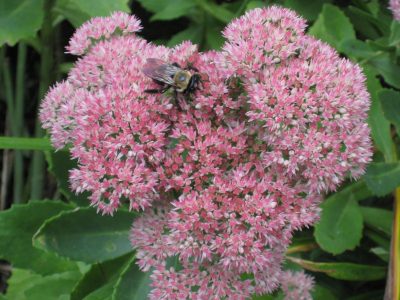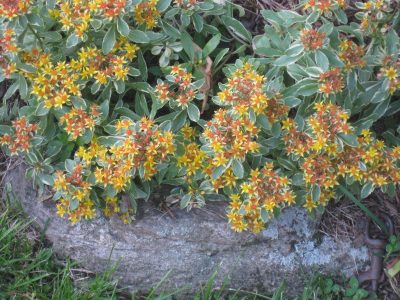By Abigayle Ward, UConn Dept. of Plant Science & LA Graduate Student

With varieties native to North America, tolerance to frigid temperatures down to minus 40 degrees F, and nearly 500 species described, sedums subvert all expectations of a succulent. Also known as stonecrop, sedums have been a garden favorite since the 17th century, and it’s easy to see why. Their visual interest and tolerance of harsh growing conditions make them well-suited as groundcover for the landscaper with an artistic eye.
You can purchase either tall or creeping varieties of sedums. Also known as ‘clumping’ varieties, tall sedum varieties can grow up to 3 feet tall although many will only grow to 1 foot tall or less. Tall, top-heavy varieties can be prone to falling or flopping over especially if overfertilized or if they receive too much water. They are well-behaved perennials that are clump formers, and thus can be useful as focal points in garden beds. Alternatively, creeping varieties of sedums grow from 2 to about 6 inches tall. These creeping varieties will spread a few feet in every direction but do so very slowly. If you wish to fill your bed with sedums, you can stick vegetative cuttings throughout the area you want them to grow. Keep moderately moist until well rooted. Once they root, they will usually fill out your bed fairly rapidly.
With such a large variety of leaf shapes and sizes, interesting bed textures can also be created with sedums. Some varieties have large, broad, spoon-shaped leaves while others have many short, pointed leaves surrounding the main stem. You may wish to combine different textures together into one bed to make a wild, visually striking design, or try taking advantage of certain textures for specific locations in the bed. For example, you could choose short creeping varieties with small leaves for bed edges, and select slightly taller creeping varieties with larger, broader leaves to build up to the bed’s focal point.

Sedums come in a smattering of delightful color combinations from electric green to deep purple, red to teal; there’s a color of sedum for any design. Many keep their color year-round, and produce delightful bunches of tiny, colorful flowers between summer and fall, depending on the species or cultivar. The magenta, yellow, and lilac-colored petals attract pollinators in great numbers, especially between August and September here in Connecticut. The flowers persist until wintertime, when they dry out and turn brown as the plant goes dormant. While you may choose to remove the flowers before the winter snowfall, you can also leave them on the plant to add some color contrast in your garden as the brown stalks are surrounded with snow. Additionally, leaving the dried flowers on the plants may help creeping varieties spread, as the tiny seeds fall to the ground and germinate come springtime.
While generally very tolerant of adverse growth conditions, sedums do best in sunny spots with well-drained soil. Luckily for those of us in Connecticut, many of our soils are well-drained. Sedums require little nutrients to thrive and typically are happy with just a spring application of an all-purpose garden fertilizer. Since sedums go dormant in the winter, no fertilizer should be applied later in the year. While other groundcover plants may need water in a drought, sedums, like most succulents, can go extended periods of time without supplemental irrigation. To top it off, their foliage is bitter, and thus unlikely to be damaged by grazing wildlife. The limited maintenance requirements of sedums make them attractive candidates for both lawn alternatives and green roofs alike.
While resistant to consumption by mammalian wildlife, the juicy sedum leaves are sometimes appealing to hungry aphids and thrips. To manage aphids and other sap-sucking insects, you can simply spray sedums with water to knock off the pests – just be mindful of overwatering, as the sedums may rot. Alternatively, you can try attracting ladybugs and other aphid predators to your sedums by planting marigolds, dill and other predator attracting plants nearby. The ladybugs will partake in the pollen and snack on the sapsuckers. Avoid spraying insecticides, as they will kill both pests and beneficial insects, including pollinators. Leaving leaf litter in your garden over the winter gives a place for ladybugs to hibernate. Come spring, newly hatched ladybug larvae will be on the hunt for a meal, ready to vigilantly defend your sedums from attacking aphids.
Your next groundcover selection can be both visually appealing and low maintenance. If you’re looking to update your groundcover, consider picking up some sedums at your local garden center in the spring or summer.
If you have questions on growing sedums or on other gardening topics, feel free to contact us, toll-free, at the UConn Home & Garden Education Center at (877) 486-6271, visit our website at www.homegarden.cahnr.uconn.edu or contact your local Cooperative Extension center.